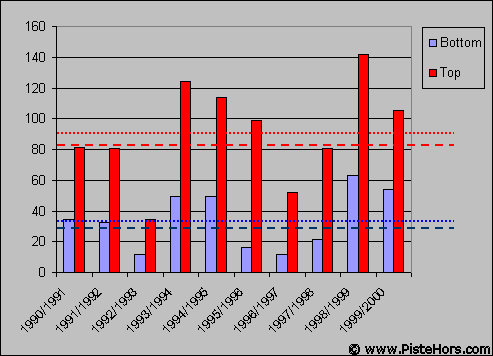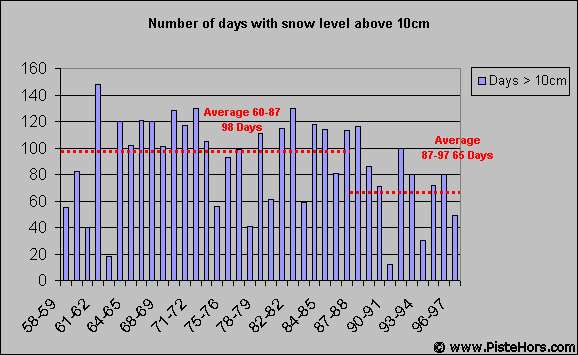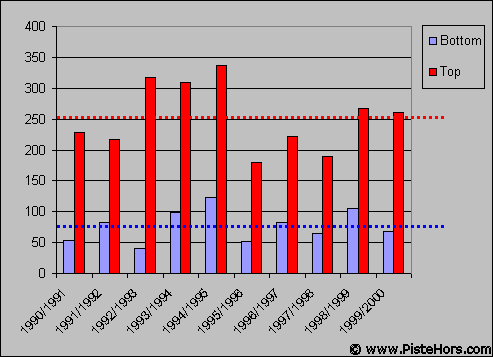
Weather > The Effects of Global Warming on Skiing > Climate Change And Skiing
At 945 meters the monastery of the Grande Chartreuse is the ideal starting point for the classic ski tour of the Grand Som. In this enclosed and relatively cold site the snow level has been recorded regularly, one could even say religiously, by the monks since the end of the 1950s. In the last ten years the average snowfall has been 330 cm, that is, 30% less than the preceding three decades. Month by month it is December, January and March that have the least snow with February resisting the best. However these figures exclude the exceptional year of 98-99. If we compare with the figures reported by the ski station of Villard de Lans (around the same height as the Monastery of the Chartreuse although on the more southerly Vercors plateau) we see that if we take the decade 90-00 (dotted line) rather than 90-97 (dashed line) we see that the figures are better at both high and low altitudes.

Snowfall figures for Villard de Lans
If these figures are similar for the Chartreuse site we see that the last decade is roughly similar to that of the 1950s with the two decades in between, a time when the ski industry expanded enormously, providing some bounty years. As a stock market analyst would say, past performance is not necessarily a good guide to the future. Two things do seem clear about the last ten years, there is more volatility and bad years particularly affect lower altitudes. So it is not just a question of precipitation but temperature. Perhaps of more significance is to examine the number of days with snow cover, that is a snow depth of more than 10 cm. This has decreased by 30 days on average between November and April giving the impression of shorter and shorter winters. This is even more impressive if one takes into account the snow depth, which has decreased on average by 50-60% between December and February. The last ten years have not been particularly cold, as has been indicated by measurements taken at many sites in the mountains. In the Isère, between December and March, the temperature is between 1 to 2 degrees above the historical average. If air temperature has a direct affect on whether it snows or rains it also plays a role in thawing, especially on south facing slopes (adrets).

Total days with snow above 10cm, Chartreuse, 945 meters
The change has been impressive and is representative of the level 900-1300 meters where ski de fond (cross country skiing) is practised in the Northern Alps, where one finds the bottom of the pistes of lower ski stations and is also the starting point of numerous ski tours. However if you gain a bit of height or look towards the Southern Alps the figures seem less dramatic. For example, at St Christophe en Oisans (1650 meters) the loss is only 15% for snowfall and 30% for the snow level on the ground. Above 1800 - 2000 meters there is no significant difference in either direction. The graphic below shows the snow-levels for the top and bottom of the pistes of les Arcs, a high altitude resort in the Tarentaise area. The standard deviation is much less significant than the figures for Villard de Lans.

Snowfall figures for les Arcs
This evolution in snow level at low to medium altitude is not without consequences for ski stations and for backcountry and cross country skiers. Both will have to adapt to the new snow conditions. Most ski resorts will have to face up to snow conditions which they would have scarcely believed during the 70s. Financial difficulties will be inversely proportional to altitude but they are exactly the stations which will have to invest in artificial snow making and improving their pistes to enable skiing on less snow. For example Le Collet d'Allevard near Chambéry has invested heavily in snow canons and in Austria - where much skiing is on pastures, it is possible to ski on 40cm of snow whereas 80cm is considered a minimum for the more rugged French terrain. However snow canons need low temperatures to function, something which was lacking during the Christmas period of 2002, where heavy rainfall also washed away much of the early season snow below 2000 meters.
<< | The Effects of Global Warming on Skiing | The Future of French Skiing >>